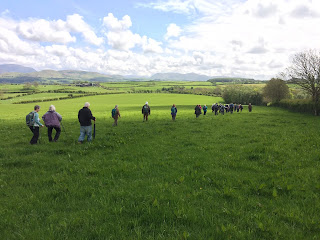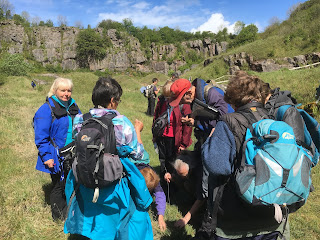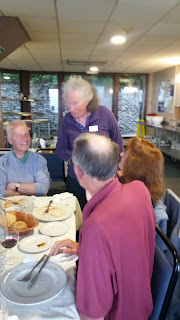 |
The view from FSC Blencathra
Image: Natalie Harmsworth |
"Day three dawned with typical lake
district weather - grey and wet, however the rain had stopped by the time we
finished breakfast and headed off in different directions. Some went to
places chosen as having few records, others went to interesting places that
still needed more records. Where they went I know not, but it seems that
all came back happy with the days efforts, though for many there was more to
come in the after dinner ID sessions that are an important part of the event.
 |
FSC Blencathra, base for BSBI's Summer Meeting
Image: Natalie Harmsworth |
"My own group headed for the little village
of Tallentire, where we briefly joined Lynne Farrell's group to decide the
strategy. We agreed to do separate monads and meet back for lunch at 1pm,
though of course that didn't quite go to plan. My team headed roughly east
and started recording when we passed a mini village green.
"At about this
point the first drops of rain fell, so the choice of waterproof paper for the
morning recording seemed a good one (Jon is after all a meteorologist, so he
had warned people).
"Our first oddity was a crucifer growing on a wall,
which didn't get identified until later, but turned out to be perhaps our best
find of the day - Draba muralis. For the most part after that there was
nothing eventful - the odd lost cow being returned to its pasture, a trailer of
sheep going past, and a few more plants being crossed off the list.
 |
View from FSC Blencathra
Image: Anne Middleton |
"By
the time we were nearing the monad boundary the rain had stopped, with patches
of blue sky, and although we pressed on for a short while looking for a lunch
spot, it was quite windy, so we back-tracked to the shelter of a quarry that we
had decided to do on our way back.
"This proved to be a nice calcareous
site, with Plantago media, Poterium sanguisorba and what we identified on
the way back as Scabiosa columbaria amongst others. It was also a good
spot for lunch and we phoned a message to the other group that we wouldn't be
meeting up, so they should continue with their monad and then go to the
southern part of the other tetrad. It turned out that although they never
received the message, they did exactly as instructed - telepathy works!
 |
Mystery plant spotted during Day 2:
can you tell what it is?
Image: Dave Barlow |
"After lunch we continued east to record the
monad, adding a few species, but nothing special. Returning to the quarry
area, we tried the east side of the road, where a young lad had been practicing
climbing the 3m high crag. This had more calcareous plants, including
something with leaves that didn't look right for the Vaccinium seen earlier and
was quickly tied down to Genista tinctoria.
"The map showed another
quarry across the fields so we thought we might as well give it a look. Somewhat to our surprise this turned out to be completely different with Rumex
acetosella and Galium saxatile amongst other acid loving plants.
"As it
was now past 4:00pm, we headed west back along the same road towards the cars,
and did manage to spot several things we had missed going in the other
direction. A final short detour produced a few more species and we got
back to the car to find a ticket on the windscreen - a message from the other
group stating their plan.
 |
Another amazing view from FSC Blencathra
Image: Natalie Harmsworth |
"Back at FSC Blencathra there was a little ID work before dinner and maps for Sunday were tabled and mostly ignored as the
groups decided where they really wanted to go. Later further ID sessions
grouped people together working on all the puzzling specimens.
"For some
specimens it was a question of believing the key, for others a question of
reading the key, and for quite a lot asking Fred Rumsey and HelenaCrouch. Eventually all was done, record cards updated and time to relax or
write the blog...
"Sunday promises to be fine. Some
groups are staying close to Blencathra, others going to designated
squares. There will be more interesting finds, and quite a few more dots
on the species distribution maps for Cumbria".
 STOP PRESS Just in from Tim Rich:
STOP PRESS Just in from Tim Rich: 


























